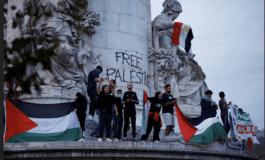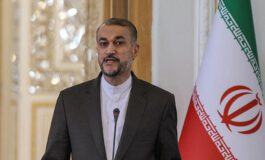KABUL (IPS) — On the surface, it would seem unlikely that Afghan President Hamid Karzai, who presides over a politically feeble government and is highly dependent on the U.S. military presence and economic assistance, would defy the United States on the issue of peace negotiations with the leadership of the Taliban insurgency.

|
|
An Afghan National Army soldier searches an Afghan man near Shamulzai FOB in Zabul province, southern Afghanistan, February 3, 2010. REUTERS/Baz Ratner |
The peace negotiations issue is imbedded in a deeper conflict over U.S. war strategy, which has provoked broad anger and increasing suspicions of U.S. motives among Afghans, including Karzai himself.
The current source of tension is Karzai’s proposal, first made last November, to invite Taliban leaders — including Mullah Omar — to a national “Loya Jirga” or “Grand Council” meeting aimed at achieving a peace agreement.
Secretary of State Hillary Clinton responded by pressing Karzai to demand far-reaching concessions from the Taliban in advance of the meeting. Clinton’s conditions on Taliban participation included renunciation of al Qaeda and of violence and acceptance of the Afghan constitution, conditions that would make it impossible for leaders of the insurgency to agree if they are interpreted literally.
On Nov. 23, Clinton said the United States had “urged caution and real standards that are expected to be met by anyone who is engaged in these conversations, so that whatever process there is can actually further the stability and peace of Afghanistan, not undermine it.”
Instead, Karzai publicly asked the United States to join in talks with the Taliban. Following the issuance of a statement by Mullah Omar on Nov. 25 that implied the Taliban would negotiate if they did not have to give up their demand for withdrawal of foreign troops, Karzai said there was an “urgent need” for negotiations with the Taliban.
In the face of what he knew was U.S. hostility to the idea, Karzai announced on Dec. 3, “Personally, I would definitely talk to Mullah Omar. Whatever it takes to bring peace to Afghanistan I, as Afghan president, will do it.”
But he added, “I am also aware that it cannot be done by me alone without the backing of the international community.” That is the phrase Karzai uses to refer to the United States and its NATO allies.
A few days later, Karzai appeared to give way to U.S. pressure against unconditional talks. He said he wanted to negotiate with Mullah Omar, “provided he renounces violence, provided all connections to al Qaeda and to terrorist networks are cut off and denounced and renounced.”
But Karzai announced at the London Conference that he would invite the leadership of the Taliban to a Loya Jirga without specifying that they would have to meet specific conditions in advance of the meeting.
The Obama administration again reacted with scarcely-disguised disapproval. The State Department spokesman repeated the U.S. line that “anyone who wants to reconcile and play a more constructive role in Afghanistan’s future must accept the constitution, renounce violence and publicly break with extremist groups such as al Qaeda.”
Clinton pointedly avoided endorsing the invitation and did not use the word “reconciliation,” which is the term in U.S. counterinsurgency doctrine reserved for negotiations with insurgent leaders. Those conditions for participation in negotiations would represent demands for concessions by the Taliban on all key issues before negotiations even begin.
Karzai showed no signs of turning back from his intention to meet with the Taliban without conditions. Two days after the London Conference, Karzai announced that he would convene the peace conference in less than six weeks.
And in an implicit response to U.S. demands for conditions on participation in negotiations, Karzai called on the Taliban not to pose the condition that U.S. troops must be removed before negotiations could begin.
In fact, a statement by Mullah Omar on Nov. 25 did not say foreign troops had to be withdrawn before peace talks could begin, but only that the Taliban would not participate in “negotiations which prolongs and legitimizes the invader’s military presence…”
Significantly, the Taliban spokesman did not dismiss Karzai’s invitation out of hand, as might have been expected, but announced that the Taliban would make a decision “soon” on attending the conference.
The growing divergence of U.S. and Karzai’s policy toward the Taliban appears to be imbedded in a wider clash over U.S. war policy.
Karzai has not been as enthusiastic as the Obama administration about the prospects for weakening the Taliban by offering economic incentives for individual commanders and troops to abandon the insurgency, which he has viewed as competing with his own emphasis on reaching a peace agreement with the Taliban leadership.
In an interview with al-Jazeera in early January, Karzai said he would not request more money to reintegrate individual Taliban fighters into the government side.
Instead, Karzai said he would seek to constrain U.S. military forces in the country. “We’re going to ask the international community to end nighttime raids on Afghan homes,” he said, “to stop arresting Afghans, to reduce and eliminate civilian casualties. We’re going to ask them not to have Afghan prisoners.”
Karzai’s public demands for an end to U.S. night raids on homes and continued arrests and detentions aligns his position with that of Taliban officials who have said those would be among the demands they would raise in peace talks.
Karzai’s commitment to a peace accord with the Taliban has been influenced by his own deep suspicions of U.S. motives in Afghanistan, according to leading Afghan political analyst Haroun Mir, a former aide to the Northern Alliance commander Ahmed Shah Massoud, who was killed by al Qaeda in September 2001.
In an interview with IPS, Mir said he believes Karzai’s opposition to U.S. strategy was intensified by the Obama administration’s openly declared hostility toward him in early 2009, and that Karzai has now embraced a conspiracy theory popular in Afghanistan, that the United States has ulterior motives in its military intervention in the country.
Mir said he attended a meeting with Karzai and about 30 Afghan political analysts several weeks ago in which the president presented his conspiracy theory about the U.S. presence to his guests.
“He thinks the United States is here not to fight the Taliban but for something else,” Mir said, and “wants to convince everybody of this.”
In November 2008, Karzai outraged the George W. Bush administration by offering a guarantee of the safety of Mullah Omar if he agreed to attend peace negotiations in Kabul. The State Department spokesman ridiculed the idea, saying, “One can’t imagine” that there would be “any safe passage with respect to U.S. forces.”
Karzai then defiantly posed the choice for “the international community” in a news conference as being “remove me or leave if they disagree.”
Karzai has also proposed taking the names of Taliban leaders off the United Nations “black list” in order to allow Taliban officials to travel abroad for the purpose of negotiations.
Waheed Omer, a spokesman for Karzai, said in January that Karzai would “probably” ask the United Nations to take Mullah Omar’s name off the “black list” of Taliban and former Taliban leaders.
At the London Conference, Karzai requested only that five ex-Taliban figures be taken off the list, but he indicated that he would ask for more deletions in the future.
The U.S. efforts to discourage Karzai from entering into talks with the Taliban should not be taken as evidence of opposition to such negotiations in the future, according to an official of the International Security Assistance Force (ISAF) in Kabul. The Obama administration appears to want to postpone peace talks until mid-2011 – after it has sought to weaken the Taliban by adding 30,000 more troops.
Gareth Porter is an investigative historian and journalist specializing in U.S. national security policy. The paperback edition of his latest book, “Perils of Dominance: Imbalance of Power and the Road to War in Vietnam”, was published in 2006.






Leave a Reply